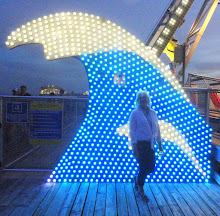 |
| Today's webcam shot - North WW |
The weather forecasts says that there's a 80% chance of rain and thunderstorms this morning. By this afternoon, it should be just cloudy with temps in the low-60s and NW winds shifting to the NE at 10-15mph. Tonight... 70% chance of rain late with temps around 50° and East winds at 5-10mph. Tomorrow... cloudy with 25% chance of rain, temps in the mid-50s with E-SE winds at 10-20mph. Tomorrow night... cloudy, temps in the mid-50s and S-SE winds at 5-10mph. Sunday... cloudy with occasional rain showers 40% chance, temps in the low-60s and SW winds shifting to the NW at 10-20mph. Sunday night... periods of rain 90% chance, temps in the low-40s and NE winds at 10-15mph.
High Tide: 1:34PM
Low Tides: 7:38AM and 7:28PM
Ocean Temp: 48°
Sunrise: 6:38AM
Sunset: 7:26PM
*The term “Cape May Bubble” is often used to describe situations where predicted storms or rain seem to split, dissipate, or change course around Cape May, leaving the area relatively unscathed while neighboring regions experience the full force of the weather event.While the term “bubble” might suggest a physical, protective barrier around Cape May, the phenomenon is, in reality, the result of a complex interplay of geographic and meteorological factors that can influence local weather patterns.
~Geographic Influence
Cape May’s unique location (including Wildwood the town just North (approximately 7 miles or 15 minutes away) plays a significant role in shaping its weather. Being a peninsula bordered by the Atlantic Ocean to the east and the Delaware Bay to the west, Cape May’s climate is heavily influenced by these large bodies of water. Water has a high specific heat capacity, meaning it can absorb and hold a lot of heat, and it warms up and cools down much slower than land. This results in a moderating influence on the surrounding air temperatures, leading to milder winters and cooler summers compared to inland regions.
~The Role of Sea Breezes
Sea breezes also play a crucial role in the Cape May Bubble phenomenon. During the day, the land heats up faster than the sea, causing the air over the land to rise and creating a low-pressure area. The cooler air over the sea then moves inland to replace the rising warm air, creating a sea breeze.These sea breezes can influence weather patterns, including storm paths. They can cause incoming storms to split or change direction as the cooler, denser sea breeze undercuts the warmer air associated with the storm, disrupting its advancement.
~Influence of Atmospheric Conditions
Lastly, the overall atmospheric conditions can impact how weather systems behave when they approach Cape May. Factors such as temperature, humidity, pressure gradients, and the jet stream can influence the path and intensity of weather systems. These conditions can sometimes align in such a way that they divert storms around Cape May, contributing to the perception of a protective bubble.While the Cape May Bubble may not be a physical shield warding off severe weather, the unique combination of geographic location, sea breezes, and atmospheric conditions can indeed influence the local weather, often making it seem distinct from the rest of New Jersey.




